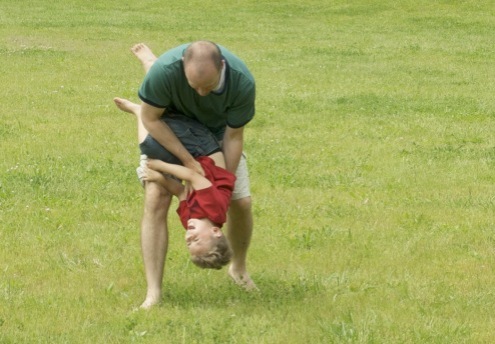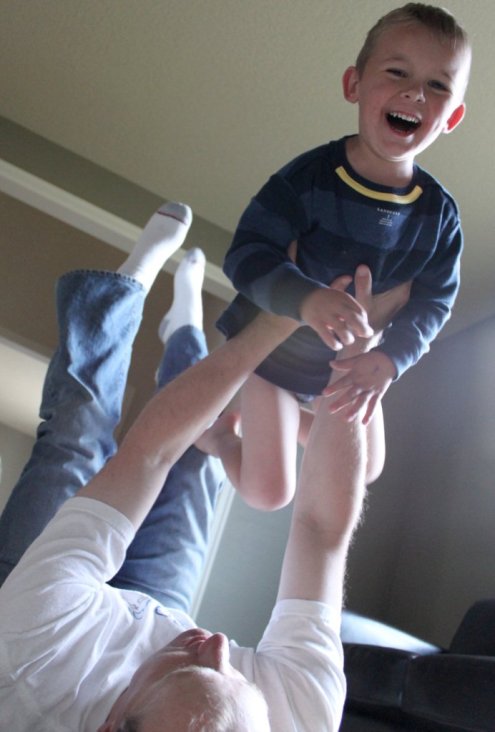Is Roughhousing Really Just Aggression in Disguise?
There is frequent roughhousing around here. Not involving me…it’s not really my cup of tea…but my husband and our kids. John is rarely averse to having a good tumble on the floor with kids tackling him from all sides, rolling over and over each other, fits of giggles all around. Our kids love it, and I happen to think it’s great for them. I see the joy and happiness on my kids’ faces and hear their squeals of laughter every time they realize Dad is coming to “get them!”
Many parents aren’t completely comfortable with roughhousing, as it can be hard to distinguish between what’s playful and what’s aggressive. One mom emailed me very upset over something she read about roughhousing, wondering why anyone would endorse such an aggressive activity for children. She thought this was the kind of thing that promotes violence in children.
It can be difficult to find the line between roughhousing (which is indeed playful) and aggression (which is hurtful). A lot of the difference lies in a child’s intent behind his actions. If a child experiences anger and frustration and lacks a proper outlet for expression, this will drive roughhousing and make it more hurtful than playful. But if a child has parents who regularly listen to his feelings, accept them wholly, allow him to cry, feel angry, etc. (thus providing that outlet), those emotions won’t manifest as aggression. It’s that difference in the drive behind the physical play that is key.
And if kids have parents who play and roughhouse with them, they will learn appropriate boundaries for physical play and be much more empathic and understanding of their playmates.
True, it is possible for kids to be raging and venting under the guise of roughhousing. While we certainly don’t want that for our kids, avoiding roughhousing altogether is not the answer. Doing so will not prevent violence in our culture. Rather, raising children in secure relationships with plenty of acceptance, empathy and closeness will. This is what allows kids to process emotions in a healthy way and not move to aggression because they’re feeling “stuck” with their feelings.
Some kids are naturally very prone to very physical play while others are not. This is why, if children are inclined to roughhouse, it is so important for parents to be strong participants in their children’s play and guide them in learning the “how-tos” and boundaries of roughhousing without teaching violence. Roughhousing together can actually be one possible way of strengthening that relationship between parents and children.

There are also many benefits to other types of physical play like sports and other physical childhood games. So if roughhousing doesn’t sit well with you, don’t worry that it’s something you have to do. There are other opportunities for kids to get some of the same benefits roughhousing yields, such as motor skills, emotional intelligence, fairness, and self control. For many families though, including ours, roughhousing does happen to be a great way to connect.
It turns out I need not have worried what our kids were learning when they grew old enough to get rough-and-tumble with John. Not aggression….just play. And that Dad’s body slams are a sign of love.




A Time and a Place for Play, Part 2 | Cognitioneducation said,
July 25, 2013 at 9:53 am
[…] Is Roughhousing Really Just Aggression in Disguise? (parentingfromscratch.wordpress.com) […]
PJay said,
August 3, 2013 at 11:39 am
No, it’s not aggression, it’s the opposite. It teaches boundaries, empathy and restraint. It’s why boys used to know when to stop in a fight before someone really got injured, and it’s why girls can’t stop being aggressively damaging once they start targeting someone.